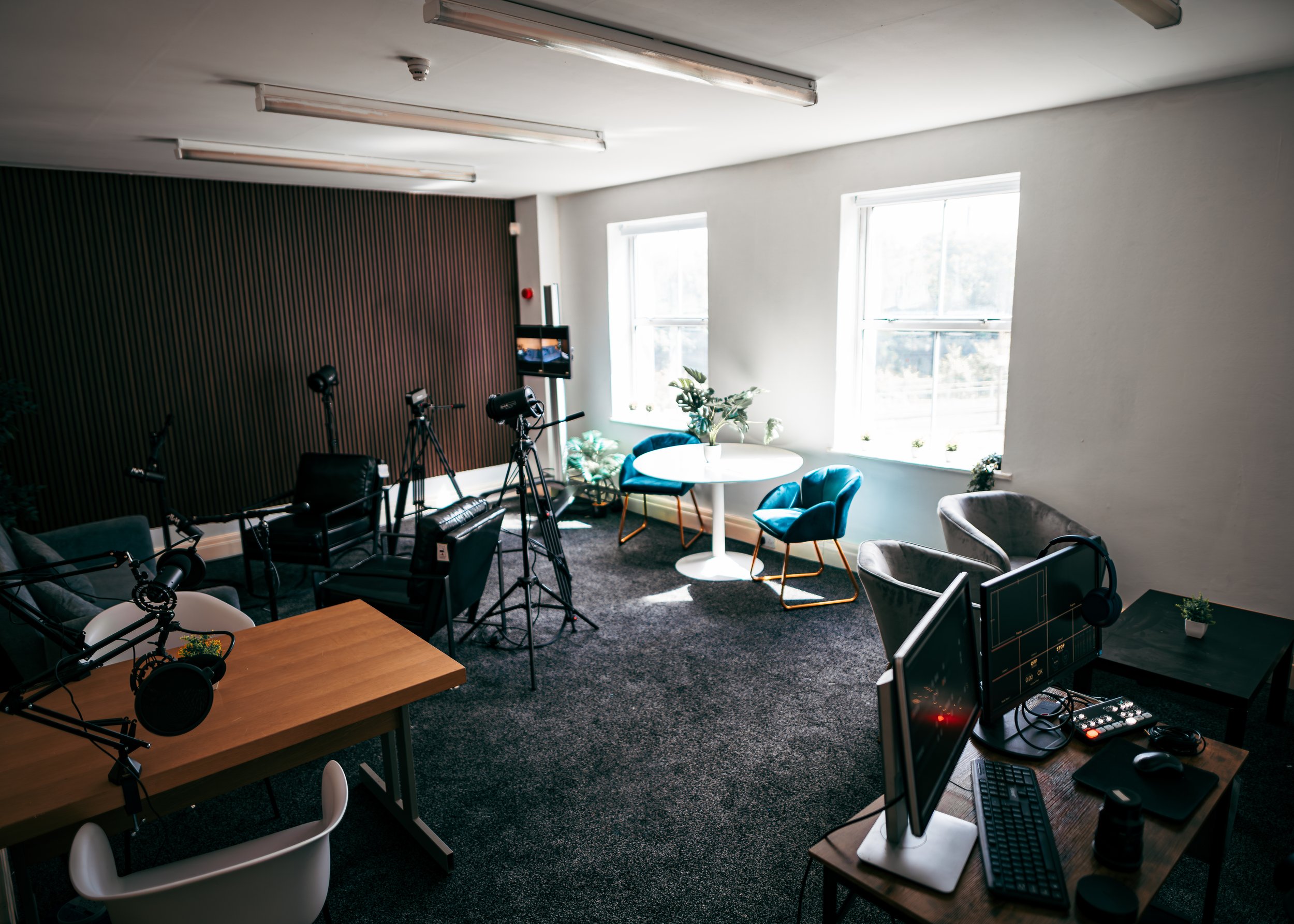Becoming a Content Creator: All You Need to Know
In today’s digital world, the role of a content creator has become more prominent than ever. With the rise of social media platforms, YouTube, blogs, podcasts, and more, the opportunities for aspiring creators are boundless. Whether you're looking to establish a brand, grow a business, or pursue a passion, becoming a content creator can provide both creative fulfilment and financial rewards. Our Title Studios Team has carefully crafted this blog post to guide you through all you need to know about content creation, including essential tips, tools, and strategies to get started. Need a full-floor studio that includes an infinity wall, greenscreen backdrop, cinema room for editing and audio recording, and a podcast room with four set-up options? Visit: Title Studios
Title Studios Podcast Room
What is Content Creation?
Content creation refers to the process of generating engaging, informative, or entertaining material that is designed to attract, inform, or entertain an audience. This content can be in various formats, including written blog posts, social media updates, videos, podcasts, infographics, and more. Content creation is a fundamental aspect of digital marketing, as it helps build brand awareness, engagement, and loyalty.
Types of Content Creation
1. Video Content Creation:
Platforms like YouTube, TikTok, and Instagram Reels have made video one of the most popular forms of content. With the increasing demand for video content, brands and individuals are leveraging these platforms to create tutorials, vlogs, product reviews, and even live streams.
Example: Think of YouTuber Casey Neistat, who turned his daily vlogs into a storytelling masterpiece, attracting millions of subscribers with his authenticity and creative visuals.
2. Written Content Creation (Blogging)
Blogging is still highly relevant in 2024. Blogs provide an excellent platform to share expertise, educate your audience, or document personal experiences. Long-form content, how-to guides, and opinion pieces are popular blog formats.
Example Neil Patel's blog, a goldmine for digital marketing enthusiasts, consistently ranks at the top due to its deep insights into SEO and marketing strategies.
3. Podcasting
Podcasts have seen a surge in popularity over the past few years. Podcast creators use audio content to share interviews, stories, and expert advice. It’s an excellent medium for people who want to consume content while multitasking (e.g., driving or working out).
Example: The "How I Built This" podcast by NPR, hosted by Guy Raz, tells the stories of entrepreneurs, giving listeners inspiration and insights into business-building journeys.
4. Visual Content Creation (Graphics, Infographics, Photography)
Visual content, such as infographics and professional photography, helps communicate complex information quickly. With platforms like Pinterest and Instagram, visual creators have a huge audience.
Example: Canva is a widely-used tool for non-designers to create professional-quality graphics easily. Many successful Instagram influencers use it to design eye-catching posts.
5. Social Media Content Creation
Short-form content on platforms like Twitter, Instagram, LinkedIn, and Facebook is a great way to build an audience quickly. Social media posts can vary from memes, short updates, images, polls, or event announcements.
Steps to Become a Successful Content Creator
1. Identify Your Niche and Audience
A critical first step in becoming a content creator is choosing a niche. Your niche will guide the type of content you create and help you attract the right audience. For instance, if you're passionate about fitness, your niche might focus on home workouts, nutrition, or fitness gear reviews.
2. Select Your Platforms
After identifying your niche, choose platforms where your audience is most active. Some content creators focus on one platform, while others distribute their content across multiple platforms.
Example:
- YouTube: For long-form video content.
- Instagram and TikTok: For short, engaging visuals and videos.
- LinkedIn: For professional and business-focused content.
- Blogging (WordPress or Medium): For in-depth written content.
3. Content Planning and Strategy
- Consistency is key to growing an audience. Create a **content calendar** to plan out your posts weeks or even months ahead. This ensures you always have fresh content to publish. A solid content strategy involves deciding how frequently you’ll post, the themes you’ll cover, and how you’ll promote each piece of content.
Example: Many content creators use tools like Trello or Notion to organise their ideas, track progress, and ensure they’re publishing consistently.
4. Invest in the Right Tools
- The right tools will help you create high-quality content and increase productivity. Here are some essential tools for different types of content:
- Video: Adobe Premiere Pro, Final Cut Pro, or DaVinci Resolve for video editing.
- Graphics: Canva or Adobe Photoshop for designing visuals.
- Blogging: WordPress or Medium as platforms; Grammarly for editing.
- Podcasting: Audacity or Adobe Audition for audio editing, and Buzzsprout for hosting. check out our studios: Title Studios
5. Develop Your Brand
- Your personal brand is a reflection of who you are and what you stand for. It should be consistent across all platforms. Choose a logo, colour scheme, and voice that align with your content and appeal to your target audience.
Example: Emma Chamberlain, a famous content creator, has a distinct voice and aesthetic that sets her apart on platforms like YouTube and Instagram.
6. Engage with Your Audience
- Audience engagement is essential to building a loyal community. Respond to comments, create interactive content (e.g., polls or Q&As), and encourage your audience to share their thoughts. Engagement not only strengthens relationships but also boosts your reach via algorithms on platforms like Instagram and YouTube.
Example: Mr Beast, a YouTube sensation, frequently interacts with his audience through challenges and giveaways, making his content more engaging and relatable.
The All Important One: Monetizing Your Content
Creating content can turn into a lucrative career if approached strategically. Here are a few ways content creators make money:
1. Ad Revenue
- Platforms like YouTube and blogs offer ad monetization, allowing creators to earn based on views and clicks.
Example: YouTube creators can apply for the YouTube Partner Program (YPP) once they reach 1,000 subscribers and 4,000 watch hours, unlocking ads on their videos.
High-Volume Keywords: "how to monetize YouTube channel," "earn money from ads on blog"
2. Sponsorships and Brand Deals
- Brands are always looking to partner with influencers to reach their target audiences. Once you've built a solid following, you can negotiate sponsorship deals.
Example: Instagram influencers often collaborate with brands for paid posts, where they showcase a product or service to their followers.
3. Affiliate Marketing
- Content creators can earn commissions by promoting products or services and sharing unique affiliate links with their audience. When someone purchases through the link, the creator gets a percentage of the sale.
Example: Many bloggers participate in Amazon's affiliate program, earning commissions by reviewing and recommending products.
4. Selling Products or Services
- Content creators can sell their own merchandise, digital products (like eBooks), or services (such as online courses or consulting). Platforms like Teachable and Shopify make it easy to launch a store.
Example: Entrepreneurs like Pat Flynn have built entire businesses around content creation, selling online courses and consulting services.
Challenges Content Creators Face (and How to Overcome Them)
1. Creative Burnout
- Continuously producing fresh content can lead to burnout. It's important to take breaks, stay inspired by consuming content from others, and explore new formats to keep things exciting.
2. Growth Takes Time
- Building an audience doesn’t happen overnight. Be patient and consistent. Focus on providing value to your audience, and growth will follow.
3. Platform Changes and Algorithm Updates
- Social media algorithms can make or break a creator’s reach. Stay updated on changes to platforms and be willing to adapt your strategies.
Conclusion
Becoming a content creator is a journey that involves passion, consistency, and strategic thinking. Whether you're vlogging on YouTube, writing in-depth blog posts, or posting on Instagram, the key is to produce valuable content that resonates with your audience. Stay authentic, invest in your skills, and continually adapt to changes in the digital landscape. Visit Title Studios to access the latest tools and support for video content creation.



